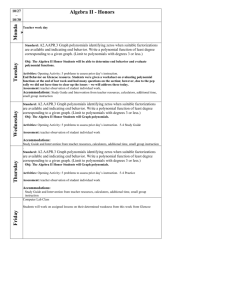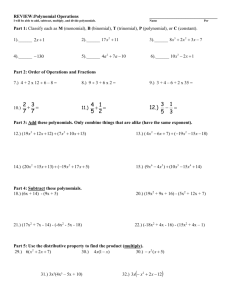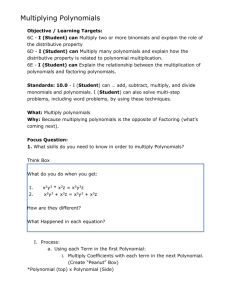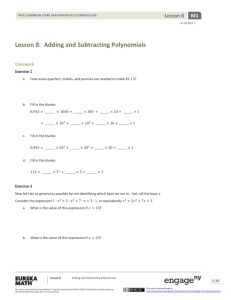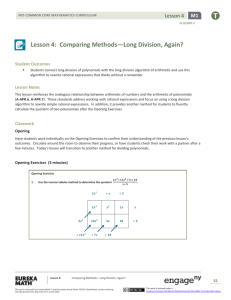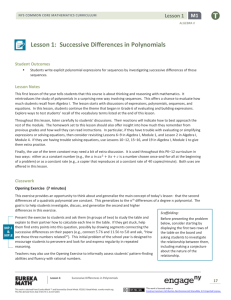Algebra II: Polynomials - Base Ten to Base X
advertisement
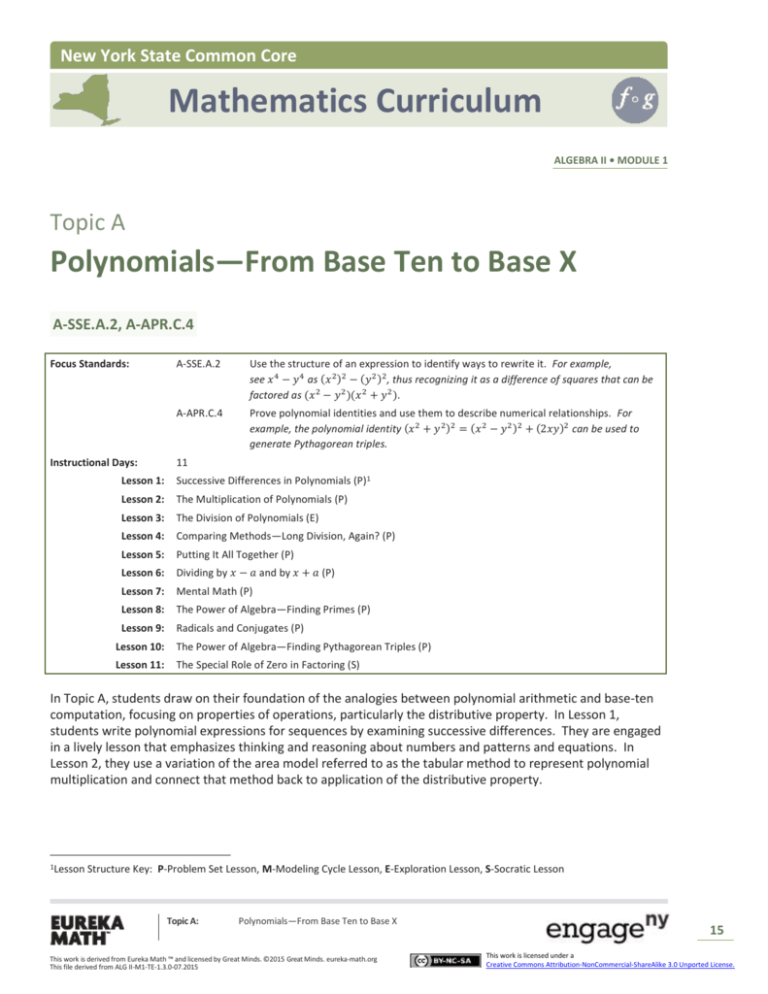
New York State Common Core Mathematics Curriculum ALGEBRA II • MODULE 1 Topic A Polynomials—From Base Ten to Base X A-SSE.A.2, A-APR.C.4 Focus Standards: Instructional Days: A-SSE.A.2 Use the structure of an expression to identify ways to rewrite it. For example, see 𝑥 4 − 𝑦 4 as (𝑥 2 )2 − (𝑦 2 )2 , thus recognizing it as a difference of squares that can be factored as (𝑥 2 − 𝑦 2 )(𝑥 2 + 𝑦 2 ). A-APR.C.4 Prove polynomial identities and use them to describe numerical relationships. For example, the polynomial identity (𝑥 2 + 𝑦 2 )2 = (𝑥 2 − 𝑦 2 )2 + (2𝑥𝑦)2 can be used to generate Pythagorean triples. 11 Lesson 1: Successive Differences in Polynomials (P)1 Lesson 2: The Multiplication of Polynomials (P) Lesson 3: The Division of Polynomials (E) Lesson 4: Comparing Methods—Long Division, Again? (P) Lesson 5: Putting It All Together (P) Lesson 6: Dividing by 𝑥 − 𝑎 and by 𝑥 + 𝑎 (P) Lesson 7: Mental Math (P) Lesson 8: The Power of Algebra—Finding Primes (P) Lesson 9: Radicals and Conjugates (P) Lesson 10: The Power of Algebra—Finding Pythagorean Triples (P) Lesson 11: The Special Role of Zero in Factoring (S) In Topic A, students draw on their foundation of the analogies between polynomial arithmetic and base-ten computation, focusing on properties of operations, particularly the distributive property. In Lesson 1, students write polynomial expressions for sequences by examining successive differences. They are engaged in a lively lesson that emphasizes thinking and reasoning about numbers and patterns and equations. In Lesson 2, they use a variation of the area model referred to as the tabular method to represent polynomial multiplication and connect that method back to application of the distributive property. 1Lesson Structure Key: P-Problem Set Lesson, M-Modeling Cycle Lesson, E-Exploration Lesson, S-Socratic Lesson Topic A: Polynomials—From Base Ten to Base X This work is derived from Eureka Math ™ and licensed by Great Minds. ©2015 Great Minds. eureka-math.org This file derived from ALG II-M1-TE-1.3.0-07.2015 15 This work is licensed under a Creative Commons Attribution-NonCommercial-ShareAlike 3.0 Unported License. Topic A NYS COMMON CORE MATHEMATICS CURRICULUM M1 ALGEBRA II In Lesson 3, students continue using the tabular method and analogies to the system of integers to explore division of polynomials as a missing factor problem. In this lesson, students also take time to reflect on and arrive at generalizations for questions such as how to predict the degree of the resulting sum when adding two polynomials. In Lesson 4, students are ready to ask and answer whether long division can work with polynomials too and how it compares with the tabular method of finding the missing factor. Lesson 5 gives students additional practice on all operations with polynomials and offers an opportunity to examine the structure of expressions such as recognizing that 1 𝑛(𝑛+1)(2𝑛+1) 6 is a 3rd degree polynomial expression with leading coefficient without having to expand it out. 3 In Lesson 6, students extend their facility with dividing polynomials by exploring a more generic case; rather than dividing by a factor such as (𝑥 + 3), they divide by the factor (𝑥 + 𝑎) or (𝑥 − 𝑎). This gives them the opportunity to discover the structure of special products such as (𝑥 − 𝑎)(𝑥 2 + 𝑎𝑥 + 𝑎2 ) in Lesson 7 and go on to use those products in Lessons 8–10 to employ the power of algebra over the calculator. In Lesson 8, they find they can use special products to uncover mental math strategies and answer questions such as whether or not 2100 − 1 is prime. In Lesson 9, they consider how these properties apply to expressions that contain square roots. Then, in Lesson 10, they use special products to find Pythagorean triples. The topic culminates with Lesson 11 and the recognition of the benefits of factoring and the special role of zero as a means for solving polynomial equations. Topic A: Polynomials—From Base Ten to Base X This work is derived from Eureka Math ™ and licensed by Great Minds. ©2015 Great Minds. eureka-math.org This file derived from ALG II-M1-TE-1.3.0-07.2015 16 This work is licensed under a Creative Commons Attribution-NonCommercial-ShareAlike 3.0 Unported License.





